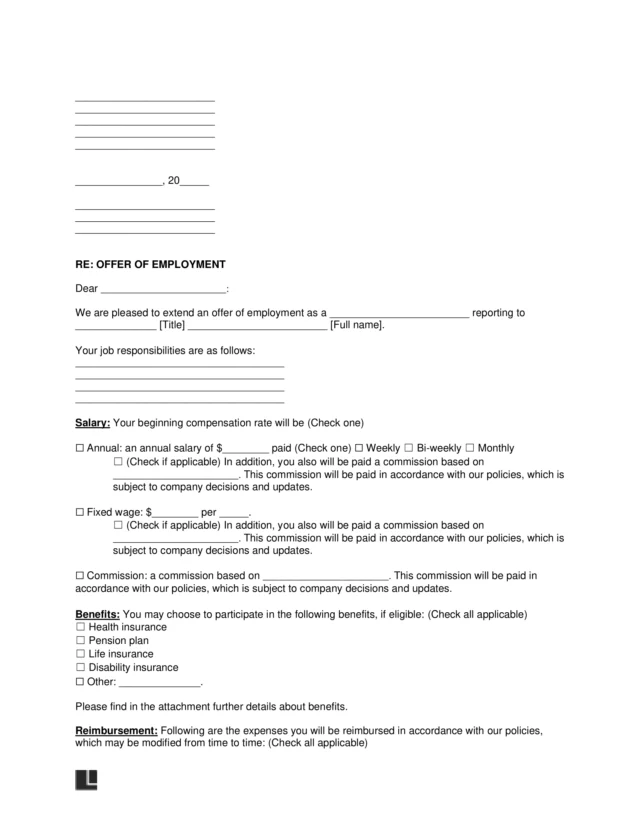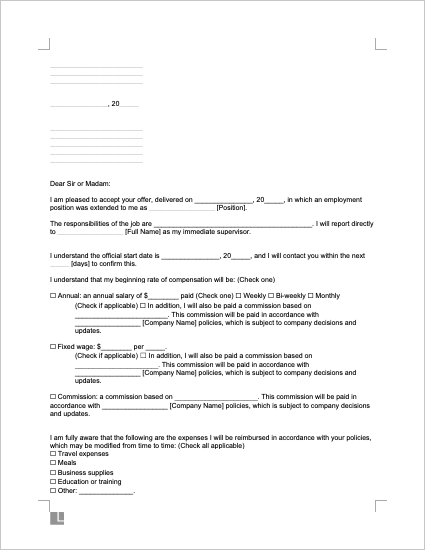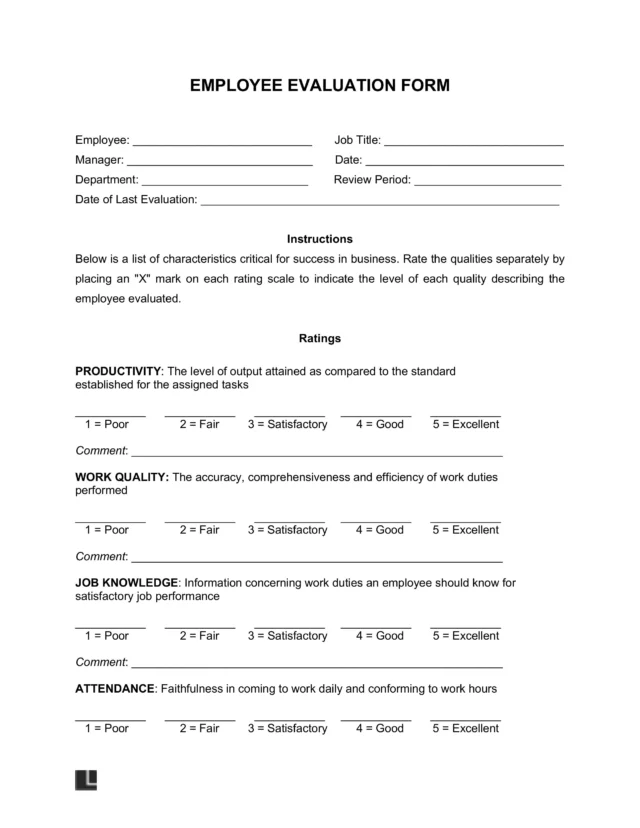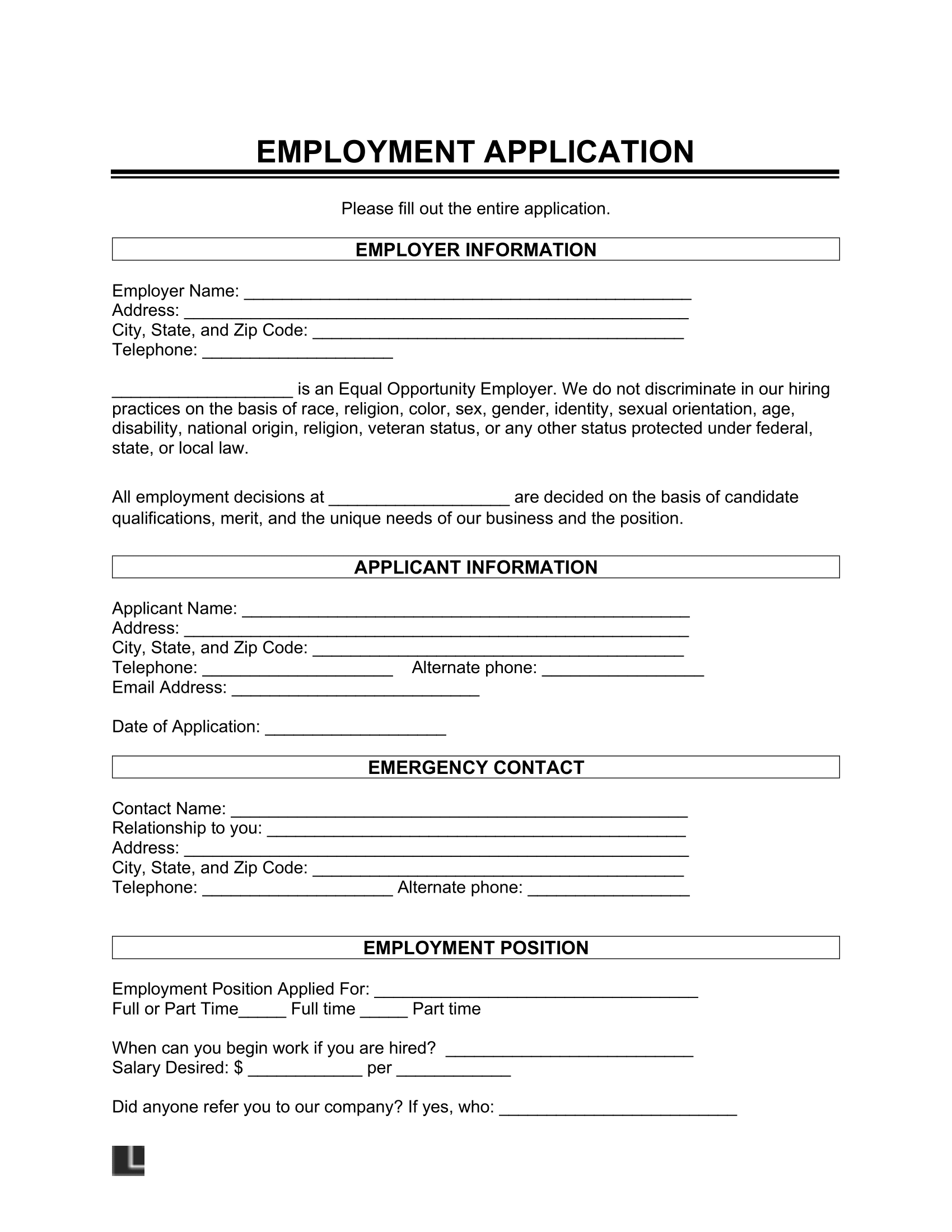What Is a Job Application Form?
A job application form is a document used to gather information from job candidates. It helps you collect key details to make a smart hiring decision. You can use it for both internal applications seeking a new role and external applicants from outside the company.
Before you send out your job application form, make sure to write a clear job description and post the role on your company website or job boards. This way, applicants know what to expect and whether they’re a good fit.
Legal Templates offers a blank job application template. Include the questions you want and download blank forms. Print them out or email digital copies to job applicants. Have them fill out their information and return the forms. Then, review them to decide which candidates to move forward with in the selection process.
Purpose of a Job Application Form
An employment application form helps employers:
- Streamline the hiring process and ensure candidates are qualified
- Standardize applications and reduce unconscious bias
- Customize questions for the role or industry
- Maintain legal compliance and professionalism
- Improve the candidate experience
- Collect and store candidate details for future hiring decisions
How to Create a Job Application Form
Creating a job application form helps you develop a consistent way to collect information from potential candidates. There’s no need to start from scratch each time. Here are the key elements to include so you can get a solid outline for your form.
1. Employer Information
Fill out this section with the employer’s name, address, and phone number. Include a statement about being an Equal Opportunity Employer to encourage more applicants. Our template comes with this statement prewritten, so you don’t have to worry about getting the wording right. We help you welcome all qualified applicants to apply, emphasizing that you don’t discriminate against protected classes, such as:
- Race
- Age
- Sex
- Religion
- Disability
- National origin
2. Applicant Information
Create a section for the applicant to input their personal details. These details include their legal name, address, and contact information. Also, allow them to add their emergency contact information. This way, you’ll have the information on file and know who to contact in case the applicant experiences a medical or workplace emergency.
3. Employment Position
Here, the applicant can specify the position to which they are applying. They can also state their preferred employment type (full-time or part-time) and salary. As an employer, you can filter out candidates by focusing on ones who respond according to the company’s needs.
4. Availability
Ask the applicant about their available start date. If they need time to resign from their current job or complete a move to a different city, they can let you know here. If applicable, ask about their availability to work overtime or specific shifts. This helps you plan your hiring timeline and ensure the candidate can meet your scheduling needs.
5. Work Eligibility
Depending on the type of job, the applicant may have to meet minimum requirements. For example, they may need to be at least 18 or have a reliable way to get to work. You can use our employment application template to create space for applicants to answer eligibility questions about:
- Whether they’re at least 18
- Whether they can provide proof of eligibility to work in the US
- Whether they have a driver’s license
- Whether they will need reasonable accommodations
- How they will get to work each day
6. Education Details
Have the applicant provide details about their educational background. They can list high school, university, or college degrees they’ve obtained. They can also specify training they’ve received in other educational facilities or specific online courses they’ve completed. This information helps you assess whether the applicant has the knowledge needed for the role.
7. Employment History
Use this section to gather an applicant’s past job experience, current employment status, and any military service. Knowing where they’ve worked, what they’ve done, and how long they stayed helps you evaluate their skills and reliability. This information gives insight into their experience, work habits, and whether they’re likely to stay in the role long-term.
8. Skills
Leave blank spaces for applicants to list hard and soft skills. They can self-assign the proficiency they have in each skill, whether it be Low, Medium, or High. These ratings can give insight into their abilities and show their confidence in performing related tasks.
9. References
Allow applicants to list personal and professional references that attest to their character and work ethic. Create spaces for them to put their references’ contact information and their relationship to the reference.
Depending on the type of job the candidate seeks, the employer may request a more in-depth reference letter.
10. Certifying Statement & Signature
Include a statement that certifies all the information is accurate to the applicant’s knowledge. Create a spot for the applicant to date and sign their name, allowing you to interpret the application as a valid submission of precise information.
Sample Job Application
View an example of a job application so you know what details to request from potential employees. When you’re ready, fill out your own using our free job application template. Download a fillable version in PDF or Word format.
What Happens After Creating a Job Application Form
Once you create an employment application form, print out copies and distribute them to potential candidates. Give them time to fill it out and submit the completed version via your preferred method, whether it be email or a physical copy.
After receiving the filled-out copies, review the responses and assess the candidates’ suitability. Request additional information as needed, like a resume or cover letter. You can also have a candidate supply a reference list so you can ask various contacts about the candidate’s work ethic and behavior. You can also schedule interviews to learn more about the applicant.
While it’s not required, consider sending a rejection letter to candidates whom you do not choose for employment. Following up with a rejection notice shows professionalism and courtesy and lets candidates know they can focus on other opportunities.
Create Your Job Application Form Today
Use Legal Templates to build your job application form in just a few minutes. You can tailor it to fit any role, whether you’re hiring for a part-time position or a full-time leadership role. Customize the questions, format, and layout so you get the right info from every applicant without the hassle.
Frequently Asked Questions
Is a job application form legally required?
No, no federal law requires employers to use job application forms. However, they’re helpful for assessing candidates’ suitability for an open role.
Can I print out a job application?
Yes, you can print out an application for employment. Legal Templates let you create a job application online and include your desired questions for candidates. Then, you can print out the template and distribute it to candidates to fill out.
What should I do if I get many job applications?
Stay focused on your company’s goals and narrow down applicants based on what the ideal candidate will look like. Prioritize the candidates that fulfill most of your qualifications, and schedule interviews to gauge their interest and compatibility.
Can I ask about criminal history on the job application form?
While there’s no federal law that stops employers from asking about criminal history on job applications, the Equal Employment Opportunity Commission (EEOC) deters it. You should only ask about information that’s relevant to the job and meets your business’s demands.
What’s the difference between a job application and a resume?
A resume is a document that a candidate creates to highlight their experience and skills, while a job application is an employer-created form filled out by a candidate for a specific job.





